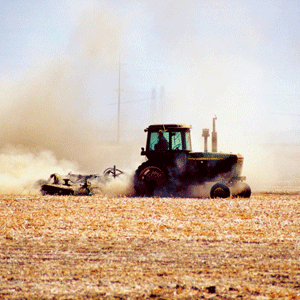In some parts of California air quality is already a big issue
This post originally appeared on KQED’s State of Health blog.

As if there wasn’t already enough to worry about, now doctors are predicting that climate change will harm people’s respiratory health. The American Thoracic Society is so concerned it filed a report with two goals. The Society not only wants to raise awareness with doctors so they can take preventive measures with their patients but also is enticing researchers to take on the question for further study. They found that climate change has a direct impact on air quality. A hotter climate, wildfires, more pollen in the air and rates of airborne diseases are worsening respiratory health worldwide.
Climate change will likely affect different places in different ways, but in California it could mean hotter summers and more wildfires. The itchy eyes and sneeze-inducing allergies that plague many people during pollen season could also hang around longer if weather patterns continue to change. All of that is bad for asthmatics, children and the elderly, but also for poor people – as it turns out.
“It was really an eye opener for us,” said Kent Pinkerton, a professor of pediatrics at UC Davis and the lead author on the report. “We were really not aware of the implications of change in temperature on respiratory health. But it really is a global issue. It’s not just a concern for here in our country,” he added. In some parts of Africa and Turkey desertification and increased particulates in the air have already forced people to relocate, often into cramped conditions, which further heightens their risk for respiratory diseases.
In California, wildfires are a blazing example of how increasing dryness and changing weather patterns harm people’s lungs. Pinkerton pointed to the summer of 2008. “We had over 1000 wildfires burning at the same time. And that really had a significant impact on air quality and particle concentration within the atmosphere,” he explained to me. Another big change — doctors are seeing infections from molds not seen before in California. “I think a good example of this has been a fungal type of infection that was only found in Central America, that is now found as far north as British Columbia, in Canada,” said Pinkerton.
So far the people most at risk are those with preexisting lung conditions, the very old and the very young. But in California’s Central Valley some of these affects have gotten so bad that doctors are seeing them in all age groups.
[module align=”left” width=”half” type=”pull-quote”]“We were really not aware of the implications of change in temperature on respiratory health. But it really is a global issue.”[/module]
“I’m seeing an increase in the last 19-20 years in the number of patients I’m seeing who are experiencing chronic lung disease,” Kevin Hamilton, deputy chief of programs at Clinica Sierra Vista in Fresno told me. ”If we see continued changes in the climate you will see resulting problems in people’s health,” he continued. Hamilton is a respiratory therapist who treats mostly low-income patients, often Latino farmworkers making their living in the Central Valley. He says in his experience if air pollution is high, people pass a threshold where they keep getting sick. He says the San Joaquin Valley often has more than 150 days a year that break the health statutes for particulate matter, fine particles in the air that can affect people’s lungs. Consistent poor air quality exacerbates — and can cause — illnesses like asthma and chronic obstructive pulmonary disease (COPD). In Hamilton’s 34 years of treating lung diseases he says he thinks it’s getting worse. Something else different — he’s seeing problems in all age groups among his low-income patients, something he doesn’t see with wealthier patients.
John Capitman, the Executive Director of the Central Valley Health Policy Institute and a professor of public health at CSU Fresno, says not all lung problems are created equally in the Central Valley. In fact, he’s also done research [PDF] that links the poorest air quality and the poorest health to communities that are low-income and often segregated. “In some of our more affluent communities we have health status outcomes that are similar to anywhere else in the country,” Capitman explained. “But in other communities, particularly low-income communities, places that are racially segregated basically, there is evidence that life expectancy is much lower.” Life expectancy is not linked solely to air quality, but exposure to high levels of particulate matter, ozone and pesticides are a contributing factor to the overall poor health that these communities experience.
That disparity is true around the world. Pinkerton’s report makes clear that many respiratory illnesses linked to a changing climate have a socio-economic component. The people in Africa being forced to relocate are often the poorest, just as the farmworkers in the Central Valley bear the brunt of poor air conditions and increased ozone.
One thought on “Doctors Expect Climate Change to Worsen Lung Diseases”
Comments are closed.


Coming as it did a day after the Union of Concerned Scientists released their report tying health risk to climate induced flooding, this is quite timely. UCS report can be found here:
http://www.ucsusa.org/global_warming/science_and_impacts/impacts/global-warming-and-flooding.html